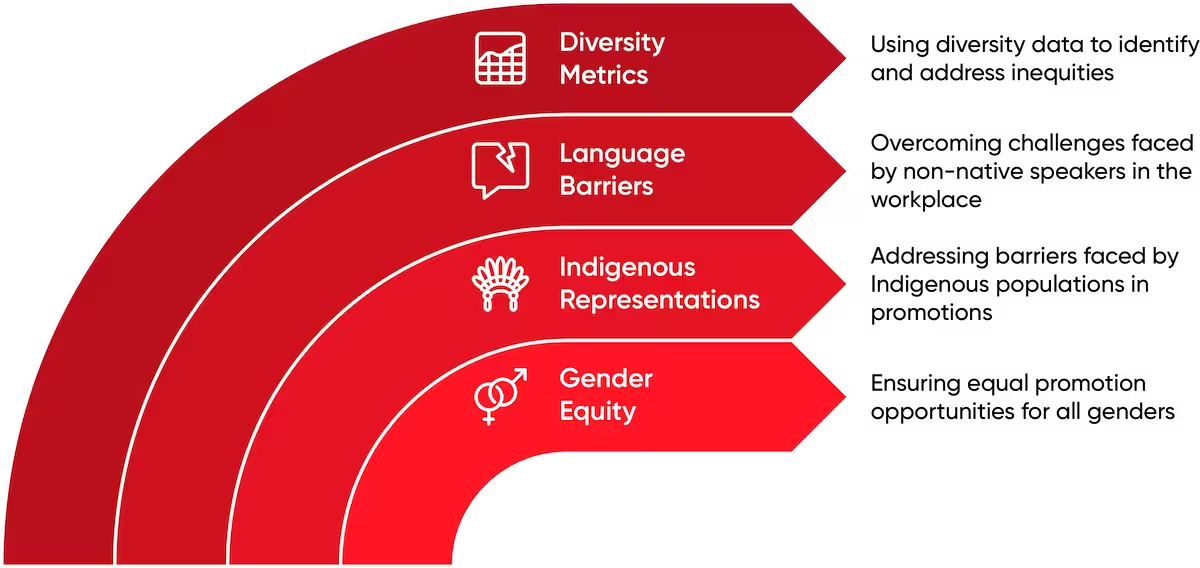
Company Culture, High Trust Behaviour, Employee Recognition, Employee Pride, Employee Trust
"Canadian workplaces are becoming much more diverse but that doesn’t necessarily mean workplace belonging is also increasing. Here's how organizations can ensure ALL of their people feel like they truly belong."
Creating a true sense of belonging at work goes beyond diversity metrics. While having team members who look like you or share similar life experiences can support workplace belonging, it doesn’t guarantee it. For example, you might excel at recruiting Indigenous students, but if they remain silent in meetings or avoid leadership training, can they genuinely feel they belong? Similarly, does your lone Sikh employee’s sense of belonging depend on hiring another Sikh colleague for company? While sameness offers comfort, belonging hinges more on feeling seen, valued, and appreciated as a whole individual.
Article Highlights
- Belonging is More Than Diversity: Diversity in Canadian workplaces is important, but true belonging means employees feel valued for who they are as individuals. This goes beyond shared identities and focuses on appreciating unique perspectives and contributions.
- Inclusive Decision-Making Drives Engagement: Engaging employees in decision-making builds connection and purpose. From strategic plans to cultural events, involving team members ensures everyone feels heard and valued, strengthening workplace inclusion.
- Recognition Builds Connections: Recognizing employees for their hard work fosters respect and camaraderie. Peer-to-peer appreciation feels genuine, boosting belonging and making people feel truly valued in their workplace.
- Bias-Free Opportunities for Growth: Fair promotion practices and accessible leadership opportunities help eliminate barriers for underrepresented groups in Canada, like Indigenous populations and newcomers, ensuring equity and inclusivity in career growth.
Workplace belonging is predicated on a fundamental choice that everyone in an organization makes, each and every day, to see and appreciate the wonderful uniqueness of everyone around them. Great workplaces make that choice, and they are deliberate in their commitment to create belonging For All.™ And once that commitment is made, our research shows that when people feel they belong they are more engaged, more innovative, and more likely to stay with their organization. All great reasons to start now and cultivate a sense of belonging in your workplace. Here’s a look at some key inclusion strategies for Canadian employers that you can implement today.
1. Embrace the individual

To foster workplace belonging, employees must feel like they can bring their whole self to work—not because of the group they are associated with, but because of who they are as unique individuals. People want to be recognized for their individuality first, and then, perhaps, as part of a broader community. Employees from different backgrounds, cultures, or beliefs bring diverse experiences and perspectives that shape who they are. These differences can be just as significant as the similarities they share with their colleagues. To create a truly inclusive workplace, it’s essential to honor the identities, traditions, and values that matter to your team members while staying curious about each person’s individual story.
2. Make employees and their ideas feel welcome

Businesses that make new team members (and their ideas) feel welcome, start with an advantage from day one. They aren’t having to play catch up to ensure ALL employees feel a sense of belonging, it’s just part of the way things are done. During the recruitment process talk about ‘fit’ in terms of values, not perspectives. Stress that sameness is not an asset and that you appreciate the rigours of discussion and debate. Support everyone in their quest for improvement and innovation and recognize that the best ideas often come from the unexpected, unexplored ideas that exist on the fringes.
3. Include employees in business decisions

Feeling connected to one’s work is also a key source of workplace belonging. To encourage high levels of engagement and purpose, companies must commit to listening. Employee surveys are good; however, they aren’t wholly sufficient. Great workplaces listen in a variety of ways. They collect qualitative data, hold listening sessions and have an open-door policy. They have robust feedback loops that include people in decisions that are important to them; from big picture strategic plans, to how to create a collaborative workspace, to what cultural events should be celebrated over the year. They follow up consistently so that people know they have been heard. When people tell you what they need, leaders must follow through. Don’t bother holding the focus group if you don’t plan to act on those insights.
4. Provide equal and transparent access to information

Although the data clearly shows that organizations that focus on purpose are more likely to have a great employee experience, it’s all academic without clear communication. Siloed communication undermines camaraderie and teamwork. It tells some workers they are on the outside, not trusted with vital business information. To create a sense of belonging in the workplace it’s imperative to communicate transparently so people trust they are being kept in the loop. When blindsided by bad news, or left out of key business decisions, people question their value and whether they really are a vital part of the team. Open, honest, and timely team wide communication helps everyone in the organization feel like a valued participant.
5. Recognize employees for their hard work

When employees are recognized for their contributions, the organization signals that it values their unique potential. Recognition programs encourage workplace belonging by building respect, caring and camaraderie. Here, recognition from managers is important, but so is peer to peer. Recognition by managers can sometimes feel expected – it’s just part of the regular one-on-ones, or it’s part of a formal recognition program. When appreciation comes from a peer however, it feels genuine and this helps boost feelings of belonging. Regardless who is doing the recognizing, the key to building belonging is sincerity. Be deliberate and thoughtful while paying attention to the uniqueness of what the person did in the context of who they are.
6. Ensure fair promotion practices

Do employees feel like promotions are awarded to deserving workers? Or do they feel some employees are overlooked? In some industries women struggle to achieve access to promotions and key work projects. In Canada, our Indigenous population experiences higher than average barriers to employment and leadership opportunities. Newcomers to Canada may also feel they are passed over in favour of people whose first language is either English or French. To help ALL people feel they belong in the workplace, development opportunities and promotions need to be accessible to everyone. Here diversity numbers can hold the key to uncovering barriers. Are there employee groups that are over or under represented in key programs or areas of you organization? If so, make a plan to remedy!
7. Vigorously examine your biases

If you are falling short in any of the points above, bias may be the culprit. Blind spots exist because we are blissfully blind to them until we decide not to be. People hold any number of seemingly innocent preconceptions that can have a cumulative negative impact on the people they work with. An executive thinks people that are part of an ERG prefer to stick together at the quarterly All Hand Meetings so she never makes an attempt to join them. A colleague has a very different political perspective from another so he avoids projects the other is involved with. A manager regularly rewards his team with a dinner out and include spouses, forgetting that one of the team is single. Over time these small oversights build friction and people begin to question their value or relationships. Then when they encounter a setback that may have nothing to do with favouritism or bias, they assume the worst. Think constantly about who and how you are promoting, rewarding, communicating with, including in your decision making, welcoming, and really seeing.
Cultivating workplace belonging requires commitment from the whole organization, from the CEO to the frontline employee. It means digging deep into the fundamentals of what creates a true sense of belonging in the workplace. Diversity may be a stepping stone, but workplace belonging is so much more. It starts and ends with seeing people as wonderfully unique individuals whose ideas and perspectives have been influenced by larger social and cultural groups. And then appreciating and noticing all the similarities and differences as you get to know each other better.
FAQs
- How can we ensure new employees feel a sense of belonging from day one?
Focus on inclusive onboarding processes, emphasize values over perspectives, and create a supportive environment where new ideas are welcomed and employees feel valued. - What are some actionable steps to make our workplace communication more transparent?
Implement team-wide updates, avoid excluding employees from critical discussions, and establish consistent feedback loops to build trust and collaboration. - How do we address biases within our organization effectively?
Provide regular bias training, review hiring and promotion practices for fairness, and ensure diverse voices are heard in decision-making processes. - How can we measure whether our employees feel a sense of belonging?
Use employee surveys, one-on-one feedback sessions, and focus groups to gather insights. Act on feedback to show employees their input is valued and impactful.
Tools & Resources
- Company Culture: Cultivating workplace belonging starts with a strong company culture that values individuality and transparency. Explore strategies to build a workplace where every employee feels seen, heard, and valued.
- Employee Engagement: Engaged employees are the foundation of a thriving organization. Learn how recognizing contributions, fostering inclusion, and encouraging innovation can elevate engagement across your teams.
- Leadership & Development: Effective leadership is critical to creating a sense of belonging at work. Discover programs that empower leaders to build trust, drive collaboration, and support growth within diverse teams.
- Diversity and Inclusion: Diversity is a stepping stone to belonging. Access resources that help you break down barriers, eliminate biases, and create a workplace where everyone feels connected and appreciated.
Feedback
We value your feedback! Your insights are crucial to helping us create meaningful content. Did the strategies in this article inspire new ways to build workplace belonging in your organization? Are there specific challenges you'd like us to address? Share your suggestions or ideas with us. Together, we can develop resources that truly make a difference. Have feedback? Fill out this form by clicking here.
Get Certified 
Want to know how your people feel about your employee benefits package? Get Certified today and learn the answer to this question and gain many more insights along the way.






